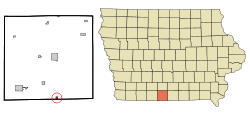Pleasanton, Iowa
Pleasanton is a city in Decatur County, Iowa, United States. The population was 49 at the 2010 census.
Pleasanton, Iowa | |
|---|---|
 Location of Pleasanton, Iowa | |
| Coordinates: 40°34′49″N 93°44′35″W | |
| Country | |
| State | |
| County | Decatur |
| Area | |
| • Total | 0.35 sq mi (0.90 km2) |
| • Land | 0.35 sq mi (0.90 km2) |
| • Water | 0.00 sq mi (0.00 km2) |
| Elevation | 1,093 ft (333 m) |
| Population | |
| • Total | 49 |
| • Estimate (2019)[3] | 44 |
| • Density | 126.80/sq mi (48.94/km2) |
| Time zone | UTC-6 (Central (CST)) |
| • Summer (DST) | UTC-5 (CDT) |
| ZIP code | 50065/50224 |
| Area code(s) | 641 |
| FIPS code | 19-63570 |
| GNIS feature ID | 0460320 |
History
Pleasanton was founded in 1854.[4] It was originally called Pleasant Plain, but the name was changed to avoid confusion with another community of that same name in the state.[5] The present name is commendatory.[6]
Geography
Pleasanton is located at 40°34′49″N 93°44′35″W (40.580274, -93.743142).[7]
According to the United States Census Bureau, the city has a total area of 0.35 square miles (0.91 km2), all land.[8]
Demographics
| Year | Pop. | ±% |
|---|---|---|
| 1880 | 117 | — |
| 1900 | 164 | +40.2% |
| 1910 | 200 | +22.0% |
| 1920 | 266 | +33.0% |
| 1930 | 177 | −33.5% |
| 1940 | 180 | +1.7% |
| 1950 | 130 | −27.8% |
| 1960 | 103 | −20.8% |
| 1970 | 62 | −39.8% |
| 1980 | 75 | +21.0% |
| 1990 | 58 | −22.7% |
| 2000 | 37 | −36.2% |
| 2010 | 49 | +32.4% |
| 2019 | 44 | −10.2% |
| Source:"U.S. Census website". United States Census Bureau. Retrieved 2020-03-29. and Iowa Data Center Source: | ||
2010 census
As of the census[2] of 2010, there were 49 people, 18 households, and 14 families living in the city. The population density was 140.0 inhabitants per square mile (54.1/km2). There were 26 housing units at an average density of 74.3 per square mile (28.7/km2). The racial makeup of the city was 100.0% White.
There were 18 households, of which 27.8% had children under the age of 18 living with them, 66.7% were married couples living together, 11.1% had a female householder with no husband present, and 22.2% were non-families. 22.2% of all households were made up of individuals. The average household size was 2.72 and the average family size was 3.07.
The median age in the city was 34.5 years. 28.6% of residents were under the age of 18; 4.2% were between the ages of 18 and 24; 22.4% were from 25 to 44; 24.4% were from 45 to 64; and 20.4% were 65 years of age or older. The gender makeup of the city was 55.1% male and 44.9% female.
2000 census
As of the census[10] of 2000, there were 37 people, 20 households, and 12 families living in the city. The population density was 107.6 people per square mile (42.0/km2). There were 24 housing units at an average density of 69.8 per square mile (27.3/km2). The racial makeup of the city was 100.00% White.
There were 20 households, out of which 15.0% had children under the age of 18 living with them, 55.0% were married couples living together, 5.0% had a female householder with no husband present, and 40.0% were non-families. 40.0% of all households were made up of individuals, and 25.0% had someone living alone who was 65 years of age or older. The average household size was 1.85 and the average family size was 2.42.
In the city, the population was spread out, with 10.8% under the age of 18, 8.1% from 18 to 24, 13.5% from 25 to 44, 35.1% from 45 to 64, and 32.4% who were 65 years of age or older. The median age was 58 years. For every 100 females, there were 105.6 males. For every 100 females age 18 and over, there were 94.1 males.
The median income for a household in the city was $51,250, and the median income for a family was $54,375. Males had a median income of $51,250 versus $18,750 for females. The per capita income for the city was $29,231. There were no families and 12.5% of the population living below the poverty line, including no under eighteens and 16.7% of those over 64.
References
- "2019 U.S. Gazetteer Files". United States Census Bureau. Retrieved July 17, 2020.
- "U.S. Census website". United States Census Bureau. Retrieved 2012-05-11.
- "Population and Housing Unit Estimates". United States Census Bureau. May 24, 2020. Retrieved May 27, 2020.
- Smith, Heman Conoman (1915). History of Decatur County, Iowa, and Its People, Volume 1. S. J. Clarke Publishing Company. p. 168.
- Savage, Tom (Aug 1, 2007). A Dictionary of Iowa Place-Names. University of Iowa Press. p. 183.
- "Mercer County Place Names, 1928–1945". The State Historical Society of Missouri. Archived from the original on June 24, 2016. Retrieved November 5, 2016.
- "US Gazetteer files: 2010, 2000, and 1990". United States Census Bureau. 2011-02-12. Retrieved 2011-04-23.
- "US Gazetteer files 2010". United States Census Bureau. Archived from the original on 2012-01-25. Retrieved 2012-05-11.
- "Census of Population and Housing". Census.gov. Retrieved June 4, 2015.
- "U.S. Census website". United States Census Bureau. Retrieved 2008-01-31.